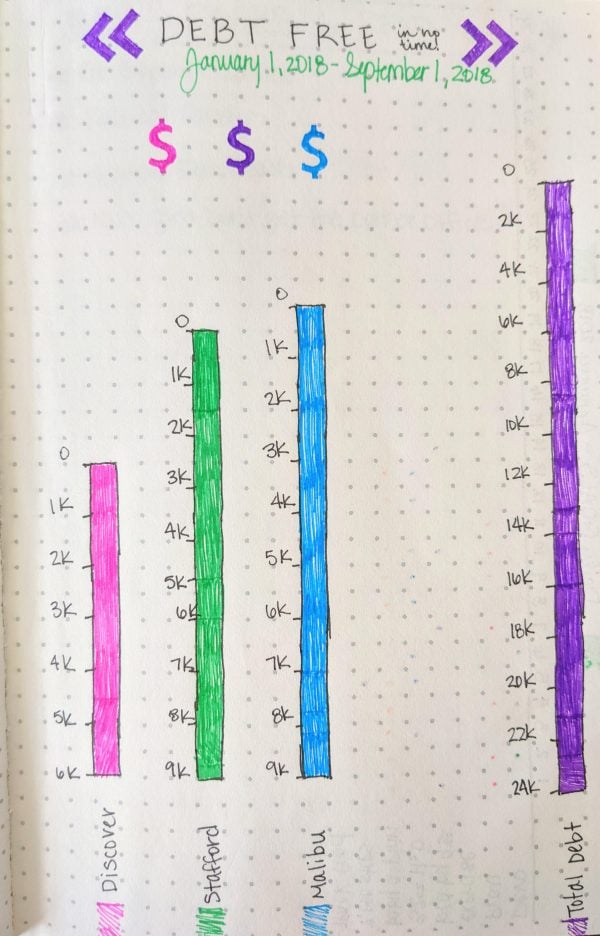Keep an Eye on Debt Using Creative Visual Aids
From coloring pages to bullet journals and spreadsheets, the internet is full of helpful tools to help you stay motivated. Here's how others have used them.

Many or all of the products on this page are from partners who compensate us when you click to or take an action on their website, but this does not influence our evaluations or ratings. Our opinions are our own.
With an $82,000 pile of debt, buying a house seemed far in the distance for Ehren Sixon and his wife, Florida residents who embarked on a debt-free journey in 2016. They opted for the debt snowball method, a debt payoff strategy that encourages motivation by quickly attacking the smallest balances first.
The couple also tracked every milestone along the way with different visual aids as they paid off car loans, student loans and credit card debt.
“We wanted to be able to track our progress and keep us motivated,” says Sixon, a 32-year-old systems engineer and part-time YouTuber.
The internet is full of debt-tracking templates that can help you log milestones toward your debt-free goals. From coloring pages to spreadsheets, here’s how you can use visual aids to demolish debt.
Visual aids motivate
If you have a long journey ahead, a road map that logs your progress can offer support and encouragement.
“You get lots of little dopamine hits from checking off those smaller milestones or those smaller elements along the way, and that really keeps motivation going,” says Katharine Iesiev, owner of She Minds Money, a financial therapy service based in Massachusetts.
Iesiev favors creating something tangible that you can print out and view often at home.
Track your progress in several ways
The Sixons turned to the internet to research debt-tracking solutions. As you explore your options, consider what will be most motivating for you.
Spreadsheets
Sixon started with a spreadsheet to keep track of all lenders, balances and debts paid off. A spreadsheet can be as simple or elaborate as necessary. You can use it to log every payment to each lender or to update balances after making a payment. A key benefit is that it can keep debt and information organized. It also pairs well with other tracking systems.
Printables for everyday viewing
The Sixons also looked at templates online to facilitate checking off debt goals. They chose a thermometer for their fridge and later moved it to the front door as a daily reminder to stay true to their goal. At every monthly check-in, they would evaluate their progress and color in the thermometer upon paying off each 10% of their debt.
“With the spreadsheet, there were times when we just got so caught up in the outstanding balances instead of celebrating how much we’d paid off so far,” Sixon says. “I didn’t realize how fun and exciting coloring a portion of that debt thermometer was, but it made our debt-free journey more enjoyable.”
Also consider coloring pages that display images like a home to represent a mortgage or a car to represent a loan. You can fill in the increments as you make payments.
For a different creative approach, a progress map can offer an appealing and discrete artistic design with unlabeled increments that you color in a similar way. For the Sixons, their bold, red thermometer became a conversation starter and inspired some friends to pay down debt.
“They were thankful that they saw the way we put it up in our house and they were able to do the same,” he says.
Bullet journals

Kaila Penner used a color-coded bar chart inside of a bullet journal to track debt payments. (Image courtesy of Kaila Penner)
A bullet journal is less visible than a page you can print and display, but it could offer more frequent engagement with your finances. Keep it as simple or creative as needed. In 2018, Kaila Penner, co-owner of the blog Frugal Twins, drew an easy bar chart inside her bullet journal to track payments toward the last remaining $24,000 from a car loan and two student loans. She colored in each bar with pink, green or blue ink after meeting every $1,000 increment.
It’s possible to break down the increments further and designate different pages for different kinds of debt. So instead of a bar chart, you could opt for drawing graduation hats, dollar bills or anything else that you can color in to represent debts paid off.
Like Sixon, Penner also used a spreadsheet throughout her entire journey, but it wasn’t as motivating as the bullet journal. “Filling that in every month was much more satisfying for me,” the Iowa resident says.
She also added a thermometer on her refrigerator door for daily visibility. With all three trackers, she logged her progress to crush the debt.
Rely on visual aids long after debt
The Sixons paid off their debt sooner than projected in 2018 by budgeting cash in envelopes and cutting back in categories like dining out and streaming subscription services. They now use a thermometer to track savings instead. In anticipation of the arrival of their baby girl, the Sixons recently colored in a thermometer indicating their savings toward a family-friendly vehicle.
“To come out in 2021 and buy a car with no car loan — fully paid off — and have it ready for our child, I didn’t think we would be at this point in our financial journey,” Sixon says. “It’s incredible.”
They’re currently using multiple thermometers that remind them to focus on priorities like paying off their home and saving for renovations and travel.
This article was written by NerdWallet and was originally published by The Associated Press.
Top image courtesy of Kaila Penner.
Find the right credit card for you.
Whether you want to pay less interest or earn more rewards, the right card's out there. Just answer a few questions and we'll narrow the search for you.

